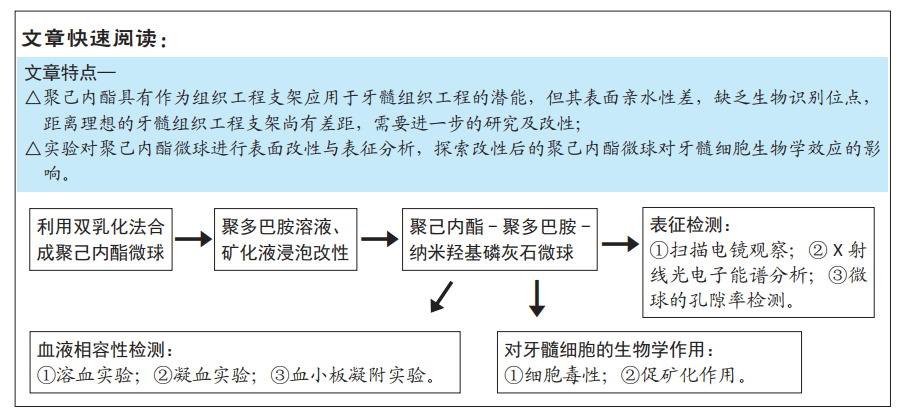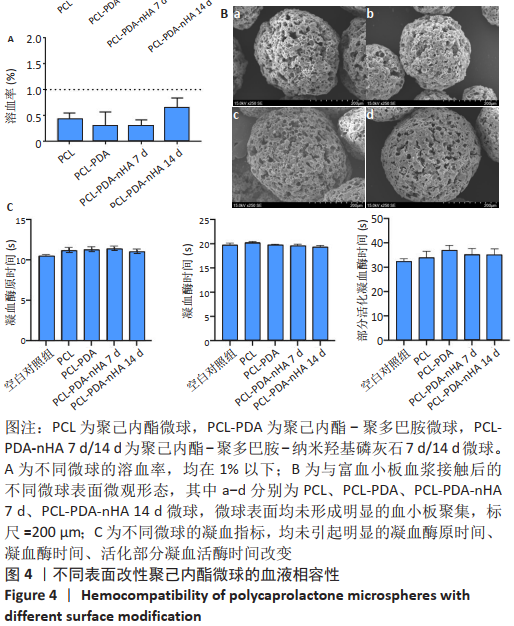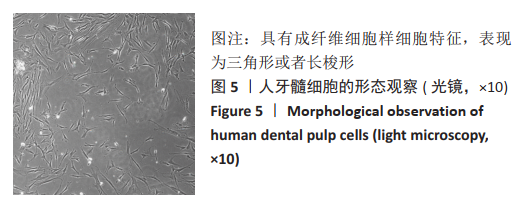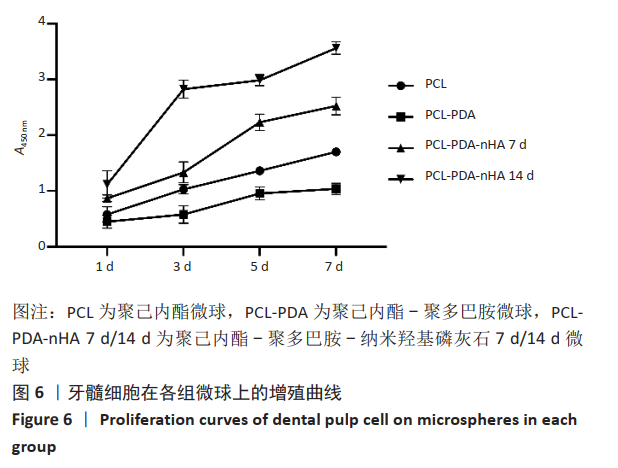[1] 樊明文.牙体牙髓病学[M]. 4版.人民卫生出版社,2012.
[2] SPIELMAN H, SCHAFFER SB, COHEN MG, et al. Restorative outcomes for endodontically treated teeth in the Practitioners Engaged in Applied Research and Learning Network. J Am Dent Assoc. 2012;143(7):746-755.
[3] PETRINO JA, BODA KK, SHAMBARGER S, et al. Challenges in regenerative endodontics: a case series. J Endod. 2010;36(3):536-541.
[4] DOYON GE, DUMSHA T, FRAUNHOFER JAV. Fracture Resistance of Human Root Dentin Exposed to Intracanal Calcium Hydroxide. J Endod. 2005;31(12):895-897.
[5] Yao Q, Wei B, Liu N, et al. Chondrogenic regeneration using bone marrow clots and a porous polycaprolactone-hydroxyapatite scaffold by three-dimensional printing. Tissue Eng Part A. 2015;21(7-8):1388-1397.
[6] 朱惠光,计剑,高长有,等.聚乳酸组织工程支架材料[J].功能高分子学报,2001,14(4):488-92.
[7] 戴炜枫,茹敏良,何月英,等.新型官能团化聚己内酯的研究进展[J].高分子通报,2008(9):10-19.
[8] LEE H, LEE BP, MESSERSMITH PB. A reversible wet/dry adhesive inspired by mussels and geckos. Nature. 2007;448(7151):338-341.
[9] HO CC, DING SJ. Structure, properties and applications of mussel-inspired polydopamine. J Biomed Nanotechnol. 2014;10(10):3063-3084.
[10] SONG Y, JIANG H, WANG B, et al. Silver-Incorporated Mussel-Inspired Polydopamine Coatings on Mesoporous Silica as an Efficient Nanocatalyst and Antimicrobial Agent. Acs Appl Mater Interfaces. 2018;10(2):1792-1801.
[11] QIAN Y, ZHOU X, ZHANG F, et al. Triple PLGA/PCL Scaffold Modification Including Silver Impregnation, Collagen Coating, and Electrospinning Significantly Improve Biocompatibility, Antimicrobial, and Osteogenic Properties for Orofacial Tissue Regeneration. ACS Appl Mater Interfaces. 2019;11(41):37381-37396.
[12] PAN H, ZHENG Q, YANG S, et al. Effects of functionalization of PLGA-[Asp-PEG]n copolymer surfaces with Arg-Gly-Asp peptides, hydroxyapatite nanoparticles, and BMP-2-derived peptides on cell behavior in vitro. J Biomed Mater Res A. 2014;102(12):4526-4535.
[13] 谭帼馨,欧阳孔友,周蕾,等.聚多巴胺螯合钙离子对钛表面的修饰及修饰后的细胞相容性[J].无机材料学报,2015(10):1075-1080.
[14] GAO X, SONG J, JI P, et al. Polydopamine-Templated Hydroxyapatite Reinforced Polycaprolactone Composite Nanofibers with Enhanced Cytocompatibility and Osteogenesis for Bone Tissue Engineering. ACS Appl Mater Interfaces. 2016;8(5): 3499-3515.
[15] LIN B, ZHONG M, ZHENG C, et al. Preparation and characterization of dopamine-induced biomimetic hydroxyapatite coatings on the AZ31 magnesium alloy. Surf Coat Technol. 2015;281:82-88.
[16] RYU J, KU SH, LEE H, et al. Mussel‐Inspired Polydopamine Coating as a Universal Route to Hydroxyapatite Crystallization. Adv Funct Mater. 2010; 20(13):2132-2139.
[17] NEGRILA CC, PREDOI MV, ICONARU SL, et al. Development of Zinc-Doped Hydroxyapatite by Sol-Gel Method for Medical Applications. Molecules. 2018; 23(11):2986.
[18] STOICA TF, MOROSANU C, SLAV A, et al. Hydroxyapatite films obtained by sol–gel and sputtering. Thin Solid Films. 2008;516(22):8112-8116.
[19] NAKAO S, TSUKAMOTO T, UEYAMA T, et al. STAT3 for Cardiac Regenerative Medicine: Involvement in Stem Cell Biology, Pathophysiology, and Bioengineering. Int J Mol Sci. 2020;21(6):1937.
[20] RAHAMAN MN, MAO JJ. Stem cell-based composite tissue constructs for regenerative medicine. Biotechnol Bioeng. 2010;91(3):261-284.
[21] WILLIAMS JM, ADEWUNMI A, SCHEK RM, et al. Bone tissue engineering using polycaprolactone scaffolds fabricated via selective laser sintering. Biomaterials. 2005;26(23):4817-4827.
[22] YANG X, YANG F, WALBOOMERS XF, et al. The performance of dental pulp stem cells on nanofibrous PCL/gelatin/nHA scaffolds. J Biomed Mater Res A. 2010; 93(1):247-257.
[23] LOUVRIER A, EUVRARD E, NICOD L, et al. Odontoblastic differentiation of dental pulp stem cells from healthy and carious teeth on an original PCL-based 3D scaffold. Int Endod J. 2018;51 Suppl 4:e252-e263.
[24] 张一.聚己内酯的表面改性及其对细胞行为的影响[D].上海:华东理工大学, 2012.
[25] Yoon H, Kim GH, Koh YH. A micro-scale surface-structured PCL scaffold fabricated by a 3D plotter and a chemical blowing agent. J Biomater Sci Polym Ed. 2010;21(2):159-70.
[26] 李俊达,陈美霖,韦晓英,等.覆盖富血小板血浆3D打印聚己内酯支架对牙髓细胞体外生物学行为的影响[J].中华口腔医学研究杂志(电子版),2017, 11(3):149-156.
[27] 刘宗光,屈树新,翁杰.聚多巴胺在生物材料表面改性中的应用[J].化学进展, 2015,27(2):212-219.
[28] 张嘉敏,汪涛,汤春波.颅骨修复钛网表面PDA/CPP涂层的制备及性能研究[J].材料科学,2017,7(1):134-142.
[29] ZHAO H, WAITE JH. Linking adhesive and structural proteins in the attachment plaque of Mytilus californianus. J Biol Chem. 2006;281(36): 26150-26158.
[30] 叶玲.再生性牙髓治疗方法的前景[J].口腔医学,2016,36(11):961-967.
[31] 侯丽,乔春霞,赵增琳.解读ISO 10993-4:2017《医疗器械生物学评价第4部分:与血液相互作用试验选择》[J].中国医疗设备,2018,33(11):1-6.
[32] NAKASHIMA M, IOHARA K, MURAKAMI M, et al. Pulp regeneration by transplantation of dental pulp stem cells in pulpitis: a pilot clinical study. Stem Cell Res Ther. 2017;8(1):61.
[33] GRONTHOS S, MANKANI M, BRAHIM J, et al. Postnatal human dental pulp stem cells (DPSCs) in vitro and invivo. Proc Natl Acad Sci U S A. 2000;97(25): 13625-13630.
[34] MIURA M, GRONTHOS S, ZHAO M, et al. SHED: stem cells from human exfoliated deciduous teeth . Proc Natl Acad Sci U S A. 2003;100(10):5807-5812.
[35] D’ANTÒ V, RAUCCI MG, GUARINO V, et al. Behaviour of human mesenchymal stem cells on chemically synthesized HA-PCL scaffolds for hard tissue regeneration. J Tissue Eng Regen Med. 2016;10(2):E147-154.
[36] GUO T, CAO G, LI Y, et al. Signals in Stem Cell Differentiation on Fluorapatite-Modified Scaffolds. J Dent Res. 2018;97(12):1331-1338.
[37] ALIPOUR M, AGHAZADEH M, AKBARZADEH A, et al. Towards osteogenic differentiation of human dental pulp stem cells on PCL-PEG-PCL/zeolite nanofibrous scaffolds. Artif Cells Nanomed Biotechnol. 2019;47(1):3431-3437.
[38] 梁倩.PCOS/bFGF调控人牙槽骨成骨细胞增殖矿化的作用研究[D].广州:暨南大学,2018.
|
 文题释义:
文题释义:





